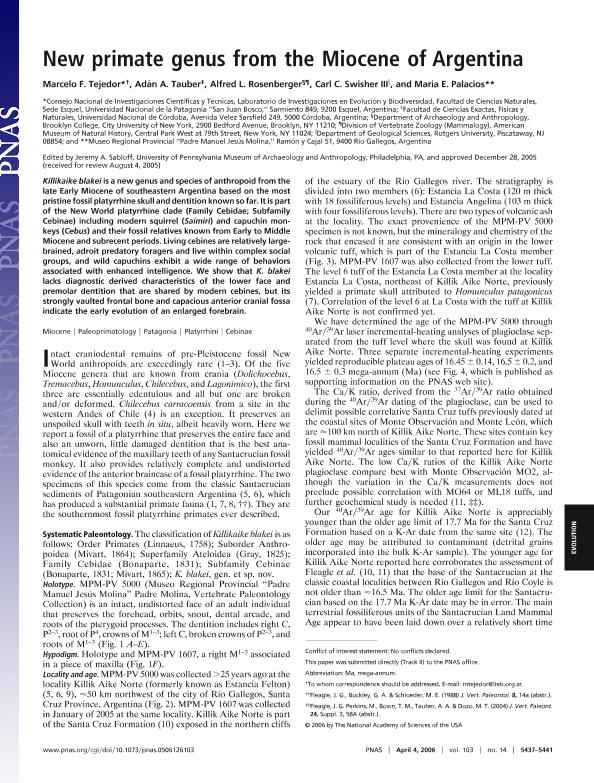Artículo
New primate genus from the Miocene of Argentina
Tejedor, Marcelo Fabian ; Tauber, Adan Alejo; Rosenberger, Alfred; Swisher III, Carl; Palacios, Maria
; Tauber, Adan Alejo; Rosenberger, Alfred; Swisher III, Carl; Palacios, Maria
 ; Tauber, Adan Alejo; Rosenberger, Alfred; Swisher III, Carl; Palacios, Maria
; Tauber, Adan Alejo; Rosenberger, Alfred; Swisher III, Carl; Palacios, Maria
Fecha de publicación:
03/2006
Editorial:
National Academy of Sciences
Revista:
Proceedings of the National Academy of Sciences of The United States of America
ISSN:
0027-8424
Idioma:
Inglés
Tipo de recurso:
Artículo publicado
Clasificación temática:
Resumen
Killikaike blakei is a new genus and species of anthropoid from the late Early Miocene of southeastern Argentina based on the most pristine fossil platyrrhine skull and dentition known so far. It is part of the New World platyrrhine clade (family Cebidae; subfamily Cebinae) including modern squirrel (Saimiri) and capuchin monkeys (Cebus) and their fossil relatives known from Early to Middle Miocene and subrecent periods. Living cebines are relatively largebrained, adroit predatory foragers and live within complex social groups, and wild capuchins exhibit a wide range of behaviors associated with enhanced intelligence. We show that K. blakei lacks diagnostic derived characteristics of the lower face and premolar dentition that are shared by modern cebines, but its strongly vaulted frontal bone and capacious anterior cranial fossa indicate the early evolution of an enlarged forebrain.
Palabras clave:
Mioceno
,
Paleopimatología
,
Patagonia
,
Platyrrhini
,
Cebinae
Archivos asociados
Licencia
Identificadores
Colecciones
Articulos(CCT-CENPAT)
Articulos de CTRO.CIENTIFICO TECNOL.CONICET - CENPAT
Articulos de CTRO.CIENTIFICO TECNOL.CONICET - CENPAT
Citación
Tejedor, Marcelo Fabian; Tauber, Adan Alejo; Rosenberger, Alfred; Swisher III, Carl; Palacios, Maria; New primate genus from the Miocene of Argentina; National Academy of Sciences; Proceedings of the National Academy of Sciences of The United States of America; 103; 14; 3-2006; 5437-5441
Compartir
Altmétricas



